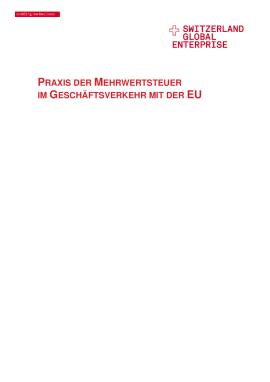We have compiled the most important information about EU VAT regulations and their impact on Swiss exporters. Our fact sheets provide more in-depth information on various aspects of the topic and can be downloaded below:
1. VAT practice when trading with the EU
Time and again, companies ask how to handle VAT correctly for cross-border transactions. Questions arise on the best way to process such transactions and deal with issues such as invoicing, tax registration, the duty to notify, etc., especially if several companies conclude contracts relating to the same item and the goods and the invoice do not take the same route. In our information sheet, you will find information about the VAT conditions to be observed in instances like this.
2. EU customs clearance
EU customs clearance refers to import customs clearance in the EU country of entry followed by tax-free intra-community delivery to another EU country. Under EU customs clearance, shipments from Swiss and Liechtenstein exporters are granted “EU status” and benefit from the same tax conditions as shipments from an EU country. Our information sheet describes the requirements and benefits for Swiss exporters.
3. Tax-free intra-community supply/tax-free intra-community acquisition
The terms “intra-community supply” and “intra-community acquisition” are frequently used in the context of an EU customs clearance or a warehouse in the EU. But what are intra-community supply and acquisition? Our information sheet explains what you need to bear in mind in this regard.
4. Warehouses in the EU
How to shorten the delivery time for cross-border deliveries of goods is a question that crops up time after time. One way to achieve this is to keep the goods in a warehouse in the EU and then remove them as required so they can be delivered to customers in the EU. Our information sheet contains information about which VAT conditions have to be taken into account in this case.
5. EU VAT rules on the cross-border trade in services
The rise of internationalization means that services are increasingly being provided on a cross-border basis. This is the case for, say, assembly work, repairs or consultancy. Our information sheet shows the VAT conditions associated with this.
6. Taxation of electronically supplied services
Electronically supplied services are services provided via the internet or an electronic network. Our information sheet describes how these services are taxed.
7. VAT registration in the EU
Unlike Switzerland, most EU countries do not have any sales limits for the VAT liability borne by foreign companies. This means that a single, low-value transaction can lead to a Swiss company becoming subject to VAT in an EU country. Our information sheet lists which transactions may trigger VAT liability and what the corresponding registration process looks like.
8. Accounting requirements in the EU
You can find out what information an invoice must contain within the EU in our information sheet.





